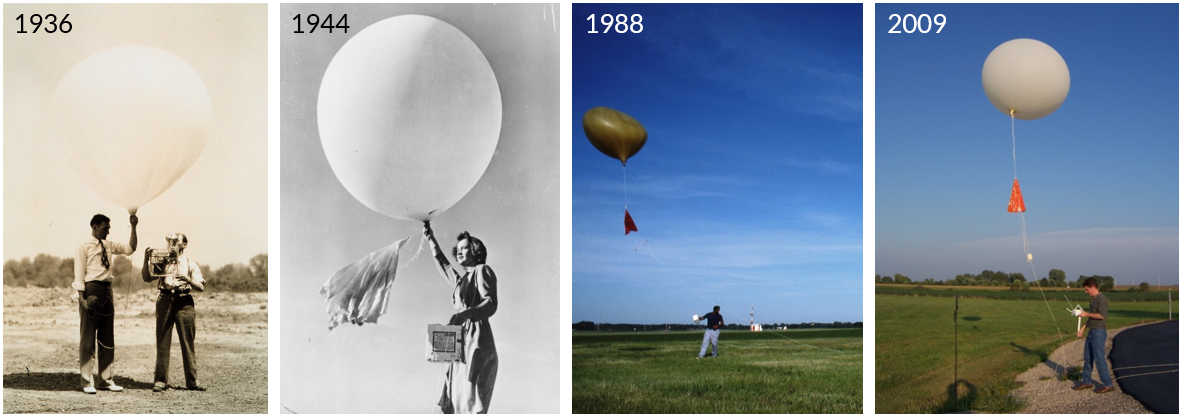History of Upper Air Observations in Illinois
The Weather Bureau (predecessor of the National Weather Service) began recording weather data aloft in the late 1800's. Observations were conducted using kites tethered to ground stations. The kites were safer than previous methods used for upper-air observations, namely using manned balloons to carry the instruments aloft (where cold and lack of oxygen proved dangerous to the pilots). However, the altitude of the kites was limited to about 3 kilometers, flights could only be conducted if the weather was good, and there was a danger of the kite breaking free. By the turn of the 20th century, unmanned balloons were available for use, but keeping them untethered meant the data recorded could be lost if the instruments could not be found after the balloon burst.
Beginning around 1925, the Weather Bureau and the Army Air Corps began to use airplanes instead of kites to obtain the upper-air weather data. Data was collected from about 20 stations. However, there were similar limitations to the previous methods -- namely not being able to conduct the observations in poor weather, having to wait for the equipment to return to analyze the data, and limits to maximum altitude due to open-air cockpits.
Pilot balloons (PIBAL's) were used to supplement this aircraft data. The first station in Illinois to conduct PIBAL's appears to be in Maywood, on the site of the current Loyola University Medical Center.
A significant change took place in the 1930's, when deployment of "radio-meteographs", or radiosondes, took place. A radiosonde sends the observed data back to the ground station using radio signals. This allowed free-rising balloons to replace the aircraft observations. Ground equipment was also used to triangulate the position of the balloon to calculate the winds aloft. The combination of the triangulation and the radio-meteograph was also referred to as a "rawinsonde". The first rawinsonde station in Illinois was opened in Joliet in 1939, and in 1945 a Radiosonde Reconditioning Center was established in Joliet to refurbish the returned radiosondes for future use.

Examples of weather balloon launches over the years
- 1898: The Weather Bureau establishes a network of upper-air observation stations using kites. The Cairo and Springfield bureau stations are part of this network.
- April 1924: The Weather Bureau teams with the U.S. Army to conduct manned balloon flights at Scott Field near Belleville, to obtain weather measurements aloft. The initial flight on April 2 carries the balloon and its passengers to South Carolina. During a flight on June 2, the two balloon passengers are killed when the balloon was struck by lightning.
- July 20, 1926: Pilot balloon (PIBAL) observations begin at the Maywood Air Field in northeast Illinois. The site of the airfield is the current location of Loyola University Medical Center in Maywood.
- September 30, 1926: The PIBAL observation function is transferred to the University of Chicago campus.
- October 1, 1926: The Weather Bureau office in Moline begins launching PIBALs, conducted 4 times a day.
- February 13, 1928: PIBAL operations are moved to the Chicago Municipal Airport (current Midway International Airport).
- July 1, 1931: The Weather Bureau in Chicago begins routine airplane observations (APOBS) of upper-air conditions, with flights taken at 4 am. Data is collected to an altitude of 16,000 feet. The contract for pilots indicated no pay would be received if an altitude of 13,500 feet was not reached; after that point, pay was $25 plus 10% for each 1,000 feet.
- July 1, 1939: The WBAS at the Joliet Municipal Airport begins launching rawinsondes. These are initially launched once per day, then increased to twice daily in April 1941.
- May 1, 1942: The PIBAL observations from Chicago Municipal Airport are transferred to the Weather Bureau Airways Station (WBAS).
- September 1944: The Army begins rawinsonde observations at Chanute Field in Rantoul. These observations are taken 4 times a day.
- April 14, 1953: Rawinsondes are discontinued at the Joliet airport; the equipment is moved to the new rawinsonde station at Green Bay, WI.
- September 12, 1956: Rawinsonde observations in central Illinois are transferred from Chanute Air Force Base to the Peoria airport. Observations continue 4 times a day until September 1957, when they are cut back to twice daily.
- December 14, 1966: Pilot balloon observations are discontinued in Springfield.
- April 14, 1968: Pilot balloon observations resume at the Midway Airport in Chicago.
- June 25, 1969: The Weather Bureau opens a contract weather station in Salem, in south central Illinois, to conduct rawinsonde observations.
- December 15, 1988: The contract NWS office in Salem is closed, and the upper-air observing function is transferred to the NWS office in Paducah, KY.
- February 15, 1995: The first upper-air observation is taken at the new NWS office in Lincoln. The day before, the last observation is taken in Peoria. The Lincoln station is actually a relocation of the Paducah, KY upper-air station; the equipment from Peoria is moved to the NWS office in Davenport, IA.
- July 23, 2007: Balloon tracking equipment in Lincoln was upgraded, to utilize Global Positioning Satellites instead of radio signals. Computers involved in the tracking were upgraded from vintage 1985 models to state-of-the-art PC's. This was part of the nationwide modernization of the upper-air observation network.
